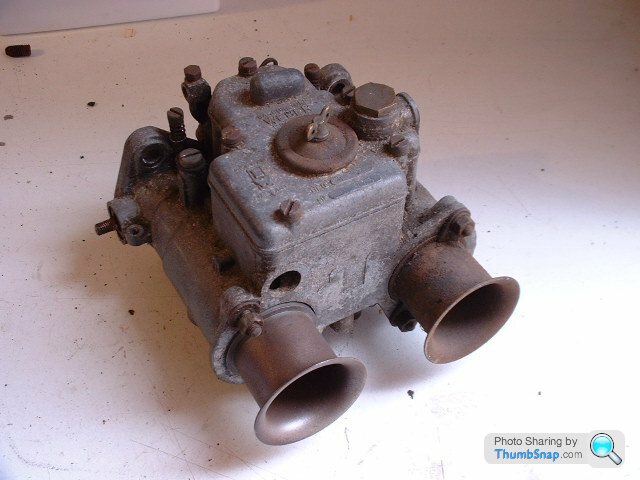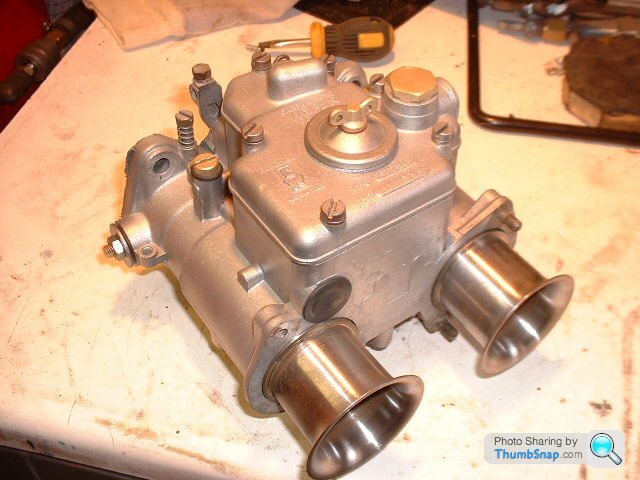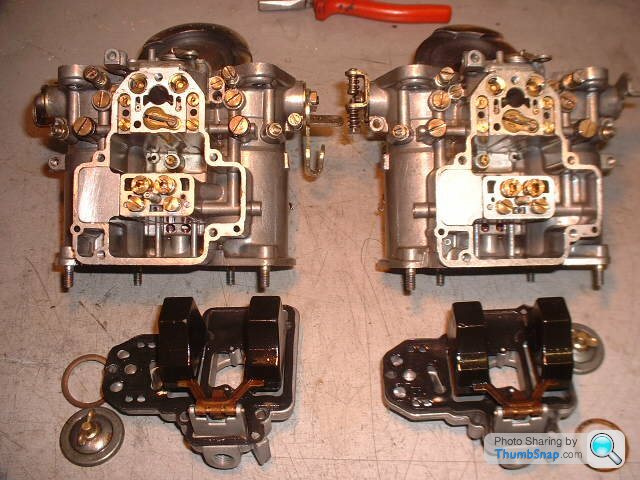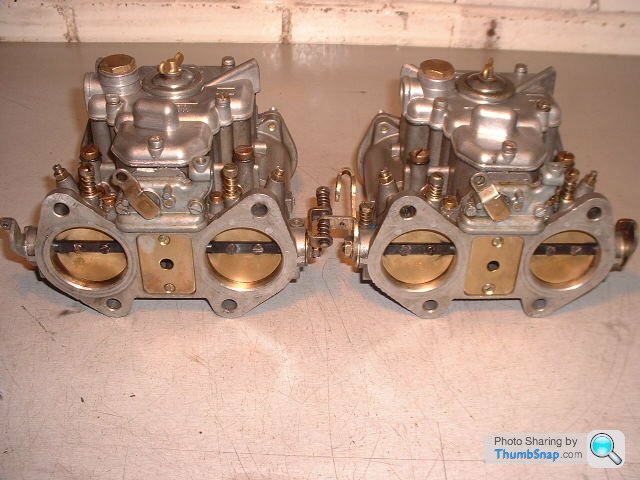Weber DCOE's - how do you remove the throttle spindle?
Discussion
Are they 49s? My manual covers 38-48.
Briefly, it says;
Grip top of spindle return spring, lift it and remove the spring anchoring plate.
Drive out the lever roll pin with a punch or 38011 400.
Bend back tab washers, unscrew nuts from each end, using 98023 700 if necessary. It's possible to bend the bend the spindle unless you're careful.
Remove nuts, tab washers, washers, lever, spring covers, springs and dust covers.
Soft hammer to tap out spindle with 1 ball bearing, taking out the pump control lever too.
Make any sense?
Briefly, it says;
Grip top of spindle return spring, lift it and remove the spring anchoring plate.
Drive out the lever roll pin with a punch or 38011 400.
Bend back tab washers, unscrew nuts from each end, using 98023 700 if necessary. It's possible to bend the bend the spindle unless you're careful.
Remove nuts, tab washers, washers, lever, spring covers, springs and dust covers.
Soft hammer to tap out spindle with 1 ball bearing, taking out the pump control lever too.
Make any sense?
I have done this many times... Its not easy, and you need a sharp tap with a steel hammer on the shaft with the carb well supported. plus gas also works wonders... you may have to tidy the threads up afterwards if you are re-using the shaft. from memory they are an odd thread... 7mm with a 1mm pitch. the shafts don't actually wear that much, the main problems is ingress of debris into to bearings, which cause them to be gritty. Bearings with seals are cheap from a bearing supplier.
Also, always buy new (quality!!) return springs as these break, or leave them off and fit external springs which is a much better Idea. If the bottom eye breaks, no problem... if the top one breaks, the spring drops down and jambs the throttle open... scary!
once assembled back with new bearings, you have to be careful to centralise the butterflies in the bore, make sure you tighten each butterfly with the throttle firmly shut. When all four screws are tight, you then have to make sure there is no twist in the shaft, this is best done AFTER you have fitted and tightened the end linkage. Use a bright light to see if both butterflies are shut together (make sure the idle adjustment screw is backed right off though)
These are precision carbs, treat them carefully. I have seen and repaired many sets of these that have been butchered in the hands of amateurs, and even good mechanics who don't understand them. Always worth having them ultrasonically cleaned, and blasted with baking powder. A nice set are a delight to work on and tune on the car... A butchered set will be a nightmare.
here are a few photos of carbs I did a few years ago...




Also, always buy new (quality!!) return springs as these break, or leave them off and fit external springs which is a much better Idea. If the bottom eye breaks, no problem... if the top one breaks, the spring drops down and jambs the throttle open... scary!
once assembled back with new bearings, you have to be careful to centralise the butterflies in the bore, make sure you tighten each butterfly with the throttle firmly shut. When all four screws are tight, you then have to make sure there is no twist in the shaft, this is best done AFTER you have fitted and tightened the end linkage. Use a bright light to see if both butterflies are shut together (make sure the idle adjustment screw is backed right off though)
These are precision carbs, treat them carefully. I have seen and repaired many sets of these that have been butchered in the hands of amateurs, and even good mechanics who don't understand them. Always worth having them ultrasonically cleaned, and blasted with baking powder. A nice set are a delight to work on and tune on the car... A butchered set will be a nightmare.
here are a few photos of carbs I did a few years ago...




johnfm said:
The weber 49 DCOE service guide says the spindles tap out with a plastic hammer.
Of course, it probably works on a carb that has just been built. On a carb where the bearings have been in for decades it might be a bit trickier
You are right... I always found a normal hammer worked better, although I sometimes did damage the thread...Of course, it probably works on a carb that has just been built. On a carb where the bearings have been in for decades it might be a bit trickier
buzzer said:
johnfm said:
The weber 49 DCOE service guide says the spindles tap out with a plastic hammer.
Of course, it probably works on a carb that has just been built. On a carb where the bearings have been in for decades it might be a bit trickier
You are right... I always found a normal hammer worked better, although I sometimes did damage the thread...Of course, it probably works on a carb that has just been built. On a carb where the bearings have been in for decades it might be a bit trickier
johnfm said:
buzzer said:
johnfm said:
The weber 49 DCOE service guide says the spindles tap out with a plastic hammer.
Of course, it probably works on a carb that has just been built. On a carb where the bearings have been in for decades it might be a bit trickier
You are right... I always found a normal hammer worked better, although I sometimes did damage the thread...Of course, it probably works on a carb that has just been built. On a carb where the bearings have been in for decades it might be a bit trickier
are you using proper penetrating oil or WD40 type?
buzzer said:
johnfm said:
buzzer said:
johnfm said:
The weber 49 DCOE service guide says the spindles tap out with a plastic hammer.
Of course, it probably works on a carb that has just been built. On a carb where the bearings have been in for decades it might be a bit trickier
You are right... I always found a normal hammer worked better, although I sometimes did damage the thread...Of course, it probably works on a carb that has just been built. On a carb where the bearings have been in for decades it might be a bit trickier
are you using proper penetrating oil or WD40 type?
HAd the carb in the oven for two hours to get it all nice and warm - still no joy.
So I am just going to re-pack the bearings and leave them in.
Gassing Station | Home Mechanics | Top of Page | What's New | My Stuff




 ks they do.
ks they do.